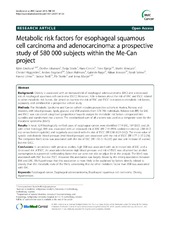Metabolic risk factors for esophageal squamous cell carcinoma and adenocarcinoma: a prospective study of 580 000 subjects within the Me-Can project
Lindkvist, Björn; Johansen, Dorthe; Stocks, Tanja; Concin, Hans; Bjørge, Tone; Almquist, Martin; Häggström, Christel; Engeland, Anders; Hallmans, Göran; Nagel, Gabriele; Jonsson, Håkan; Selmer, Randi; Ulmer, Hanno; Tretli, Steinar; Stattin, Pär; Manjer, Jonas
Peer reviewed, Journal article
Published version
Date
2014-02-18Metadata
Show full item recordCollections
Original version
https://doi.org/10.1186/1471-2407-14-103Abstract
Background: Obesity is associated with an increased risk of esophageal adenocarcinoma (EAC) and a decreased risk of esophageal squamous cell carcinoma (ESCC). However, little is known about the risk of EAC and ESCC related to other metabolic risk factors. We aimed to examine the risk of EAC and ESCC in relation to metabolic risk factors, separately and combined in a prospective cohort study. Methods: The Metabolic Syndrome and Cancer cohort includes prospective cohorts in Austria, Norway and Sweden, with blood pressure, lipids, glucose and BMI available from 578 700 individuals. Relative risk (RR) for EAC and ESCC was calculated using Cox’s proportional hazards analysis for metabolic risk factors categorized into quintiles and transformed into z-scores. The standardized sum of all z-scores was used as a composite score for the metabolic syndrome (MetS). Results: In total, 324 histologically verified cases of esophageal cancer were identified (114 EAC, 184 ESCC and 26 with other histology). BMI was associated with an increased risk of EAC (RR 7.34 (95% confidence interval, 2.88-18.7) top versus bottom quintile) and negatively associated with the risk of ESCC (RR 0.38 (0.23-0.62)). The mean value of systolic and diastolic blood pressure (mid blood pressure) was associated with the risk of ESCC (RR 1.77 (1.37-2.29)). The composite MetS score was associated with the risk of EAC (RR 1.56 (1.19-2.05) per one unit increase of z-score) but not ESCC. Conclusions: In accordance with previous studies, high BMI was associated with an increased risk of EAC and a decreased risk of ESCC. An association between high blood pressure and risk of ESCC was observed but alcohol consumption is a potential confounding factor that we were not able to adjust for in the analysis. The MetS was associated with EAC but not ESCC. However this association was largely driven by the strong association between BMI and EAC. We hypothesize that this association is more likely to be explained by factors directly related to obesity than the metabolic state of the MetS, considering that no other metabolic factor than BMI was associated with EAC.
Publisher
BioMed CentralJournal
BMC CancerCopyright
Copyright 2014 Lindkvist et al.; licensee BioMed Central LtdBjörn Lindkvist et al.; licensee BioMed Central Ltd.

